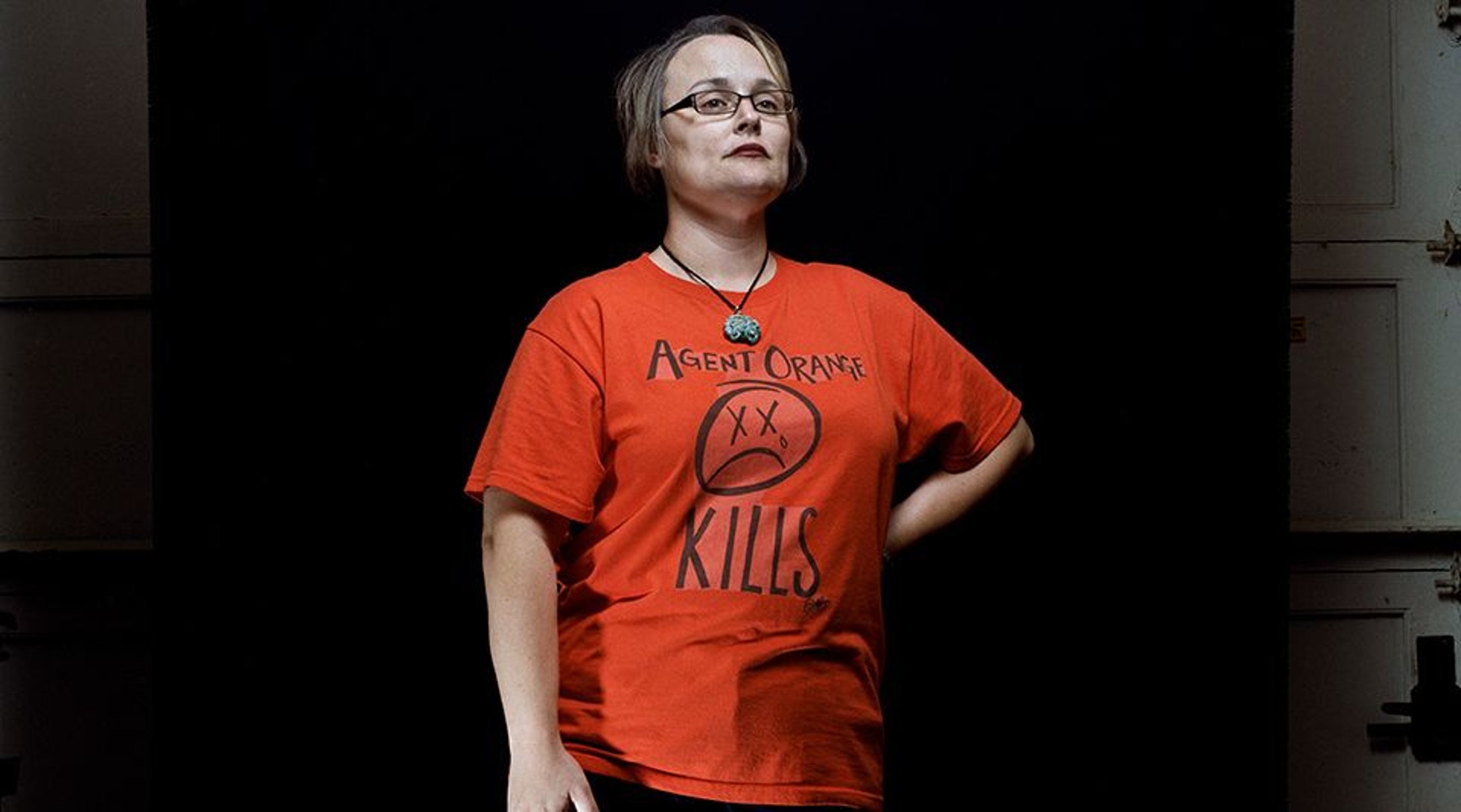Heather Bowser describes herself as a child of Agent Orange. She was born with several fingers and part of her right leg missing. Her father,
Bill Morris, fought in Vietnam and was exposed to Agent Orange. Canfield, Ohio, USA. © Mathieu Asselin. Finalist, LensCulture Portrait Awards 2016
Postcard of the former Monsanto® factory in Anniston from 1936. © Mathieu Asselin. Finalist, LensCulture Portrait Awards 2016
Heather Bowser holds a photograph of her father. Morris had served in Vietnam in areas that were sprayed by Agent Orange while he was stationed there. Morris' many health problems were directly tied to exposure to Agent Orange. Bill Morris passed away on March 11, 1998. Canfield, Ohio, USA. © Mathieu Asselin. Finalist, LensCulture Portrait Awards 2016
David Roddick. Most of us have some PCBs in our blood. The average level is 2 parts per billion. In a survey of 3,000 West Anniston residents (whose blood was tested for the lawsuit), more than a third of the population have levels greater than 10 parts per billion. Take David Roddick, who is suffering from multiple heath problems like diabetes and respiratory deficiency. West Anniston, Alabama, USA. © Mathieu Asselin. Finalist, LensCulture Portrait Awards 2016
Low-income neighborhood located
a few steps from Sauget's Superfund site. At the end of this road and behind the gates lies one of the most polluted places in the US. © Mathieu Asselin. Finalist, LensCulture Portrait Awards 2016
David Baker (65) at his brother Terry's grave. The average level of PCB in Anniston is 27 times higher than the national average. Terry Baker died at the age of 16 from a brain tumor. Edgemont Cemetery. West Anniston, Alabama, USA. © Mathieu Asselin. Finalist, LensCulture Portrait Awards 2016
Monsanto® magazine ads from 1949 to 1980. © Mathieu Asselin. Finalist, LensCulture Portrait Awards 2016
View of glass jar at Tu Du Hospital
which contain fetuses deformed as a result of the United States' herbicidal warfare (Agent Orange) program during the Vietnam War. Ho Chi Minh City, Vietnam. © Mathieu Asselin. Finalist, LensCulture Portrait Awards 2016
Thu Huyen, 8 years old, contaminated with Agent Orange. Multiple genetics disorders and malformations. Tu Du Hospital. Ho Chi Minh City, Vietnam. © Mathieu Asselin. Finalist, LensCulture Portrait Awards 2016
Monsanto® Herbicide Handbook. 2014. © Mathieu Asselin. Finalist, LensCulture Portrait Awards 2016
A house abandoned due to high levels of PCBs in close proximity to the Solutia Plant, formerly a Monsanto® plant. With more than
20,000 residents affected in this low-income area, it represents the biggest impact
on a single community by one contamination.
In recent years, Monsanto® has bought and demolished around 100 PCB-contaminated houses and businesses in the area, turning
the neighborhood into a virtual ghost town. © Mathieu Asselin. Finalist, LensCulture Portrait Awards 2016
Lee Roy Muck at his home in the Poca Basin, close to one of the Monsanto illegal dump sites. Like an alarming number of residents in the area, his wife suffered a cancer-related death. Poca River Basin, West Virginia, USA. © Mathieu Asselin. Finalist, LensCulture Portrait Awards 2016
Amber Beller holds a photograph of her mother, Shirley Beller, who died of ovarian cancer in 2006. Poca River Basin, West Virginia, USA. © Mathieu Asselin. Finalist, LensCulture Portrait Awards 2016
Kelly L. Derricks is the daughter of Vietnam veteran Harry C. Mackel Jr. Mackel died in 1982 at 37. He was exposed to Agent Orange while serving two tours of duty. Kelly has battled severe health issues all her life. Some of her illnesses are presumed to be associated with the intergenerational effects
of Agent Orange and include chronic kidney disease, Crohn's disease, Addison's disease, congenital adrenal hyperplasia, intersticial cystitis and degenerative disk disease. The complete list consists of 32 illnesses. In 2000, Kelly became permanently disabled and had to retire from
her job as a psychiatric therapist.
Kelly's daily medication. Philadelphia, Pennsylvania. 2012. © Mathieu Asselin. Finalist, LensCulture Portrait Awards 2016
In July 2004, David Runyon and his family became victims of Monsanto's persecution of farmers. Wrongly accused of using Monsanto's patented seeds,
David was coerced by Monsanto's lawyers to turn over all his business records, including taxes. Geneva, Indiana, USA. © Mathieu Asselin. Finalist, LensCulture Portrait Awards 2016
Corn Field. Van Buren, Indiana. 2013. In 1996, Monsanto® introduced its first GMO seeds. The company ensured that farmers could not save the seeds and essentially lose the ownership
of their seeds. Consequently, the power balance shifted away from the farmers to corporations who now own about 80 percent of GM corn and 93 percent of the GM soy market.
Now farmers not only have to buy the seeds from the corporations year after year, but they are also forced to comply with the rules and regulations embedded in the contracts, which are designed to put the farmers at a juridical disadvantage. © Mathieu Asselin. Finalist, LensCulture Portrait Awards 2016
PCB contamination warning sign. Due to the high level of PCBs in the ground, hundreds of residents have moved from West Anniston, and many houses have been demolished in what today looks like a ghost town.
Mo Parr is a seed cleaner. Monsanto® sued him, claiming he was "aiding and abetting" farmers and helping them to violate the patent. The company subpoenaed Parr's bank records without his knowledge and found his customers. After receiving calls from Monsanto, some of the farmers stopped talking to him. Monsanto won its legal case against Parr. Rolling Prairie, Indiana, USA. © Mathieu Asselin. Finalist, LensCulture Portrait Awards 2016



